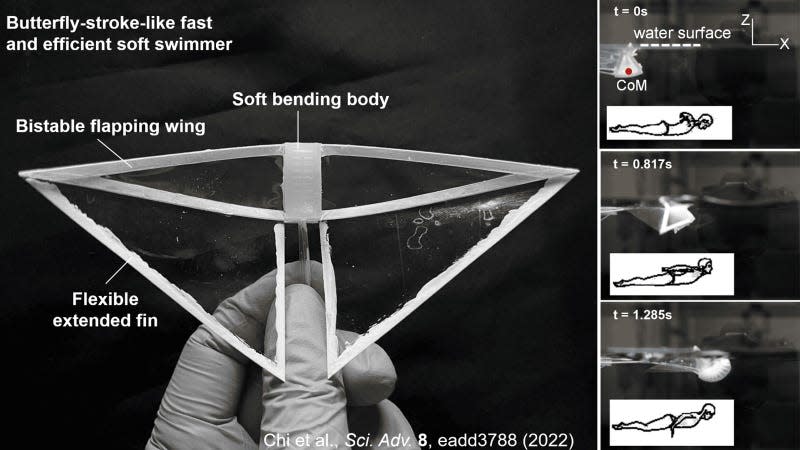This Tiny Aquatic Robot Is Faster Than an America’s Cup Yacht
Just keep swimming.
I’m a big fan of tiny robots. There’s just something incredible about these microscopic machines that could one day be used to carry out all manner of important tasks. And so far, 2022 has proven to be a big year for these small creations as scientists have developed the world’s smallest remote control robot and one of the fastest tiny robots of all time. Now, we’re moving into the ocean for a tiny aquatic robot that is faster than an America’s Cup racer.
Created by a team of researchers at North Carolina State University (NCSU), the tiny swimming robots have been inspired by the manta ray. According to Tech Crunch, the robots weigh just 2.8g and propel themselves through the waves by flapping two wings on either side of their frames.
Read more
Researchers from NCSU likened the wings on the robots to snappable hair clips. They explained that the wings are “bistable,” which means they have two stable states. This, they say, is similar to a hair clip as “a hair clip is stable until you apply a certain amount of energy (by bending it).
When the amount of energy reaches critical point, the hair clip snaps into a different shape – which is also stable.” The energy expelled by the wings snapping from one state to another is enough to propel the robot through water.

The robots apparently swim with a butterfly stroke.
As with all diminutive machines, this isn’t measured in normal units such as miles per hour, instead research measure the robots speed in body lengths per second. As Tech Crunch reports:
“Two versions of the robot were built. The first was designed specifically for speed, with the ability to move 3.74 body lengths per second — a big increase over soft robots that struggle to move a single body length in that time.
“A second, designed for more control, moves around 1.7 body lengths a second. In the first case, the design makes turning an issue. With the second, the team added a second drivetrain to turn the robot by flapping a single wing at a time.”
To get your head around what that kind of speed means when you’re dealing with regular sized things, we dug out the calculator.
An America’s Cup racing yacht comfortably travels at speeds of around 46mph when its traversing the ocean, this is equivalent to 20.56 meters per second. In a boat that’s 26m long, this gives you a speed of 1.27 body lengths per second — way slower than the tiny robots.
If you want something with a similar speed to the NCSU creations, you need to look to propellor-driven craft.
The Ferrari-powered Riva Aquarama comes close. It’s two Italian V8s propel this luxury speed boat up to 46 mph, but its much shorter 8.7m hull means this has a relative speed of 2.36 body lengths per second.
So, the mini machine is pretty speedy. But, it does have limitations that it must overcome before it can be useful. Currently, the robot must be tethered to two tubes that inflate and deflate the champers that control each wing.
A butterfly-stroke-like soft robotic swimmer that is fast and efficient
But, according to one of the researchers involved in the study, NCSU is working on another model that could cut out the tubes and allow the robots to swim freely to areas where they can carry out different tasks.
“This work is an exciting proof of concept, but it has limitations,” says Jie Yin, associate professor of mechanical and aerospace engineering at NC State.
“Most obviously, the current prototypes are tethered by slender tubing, which is what we use to pump air into the central bodies. We’re currently working to develop an untethered, autonomous version.”
Now, let’s just hope they never give the tiny robots tiny guns.
More from Jalopnik
Sign up for Jalopnik's Newsletter. For the latest news, Facebook, Twitter and Instagram.

